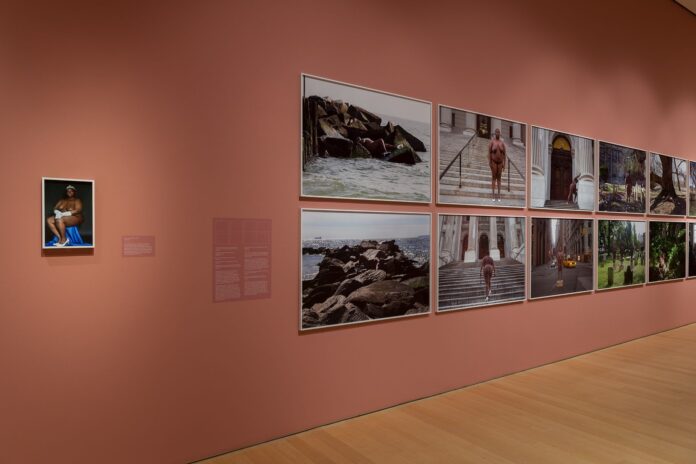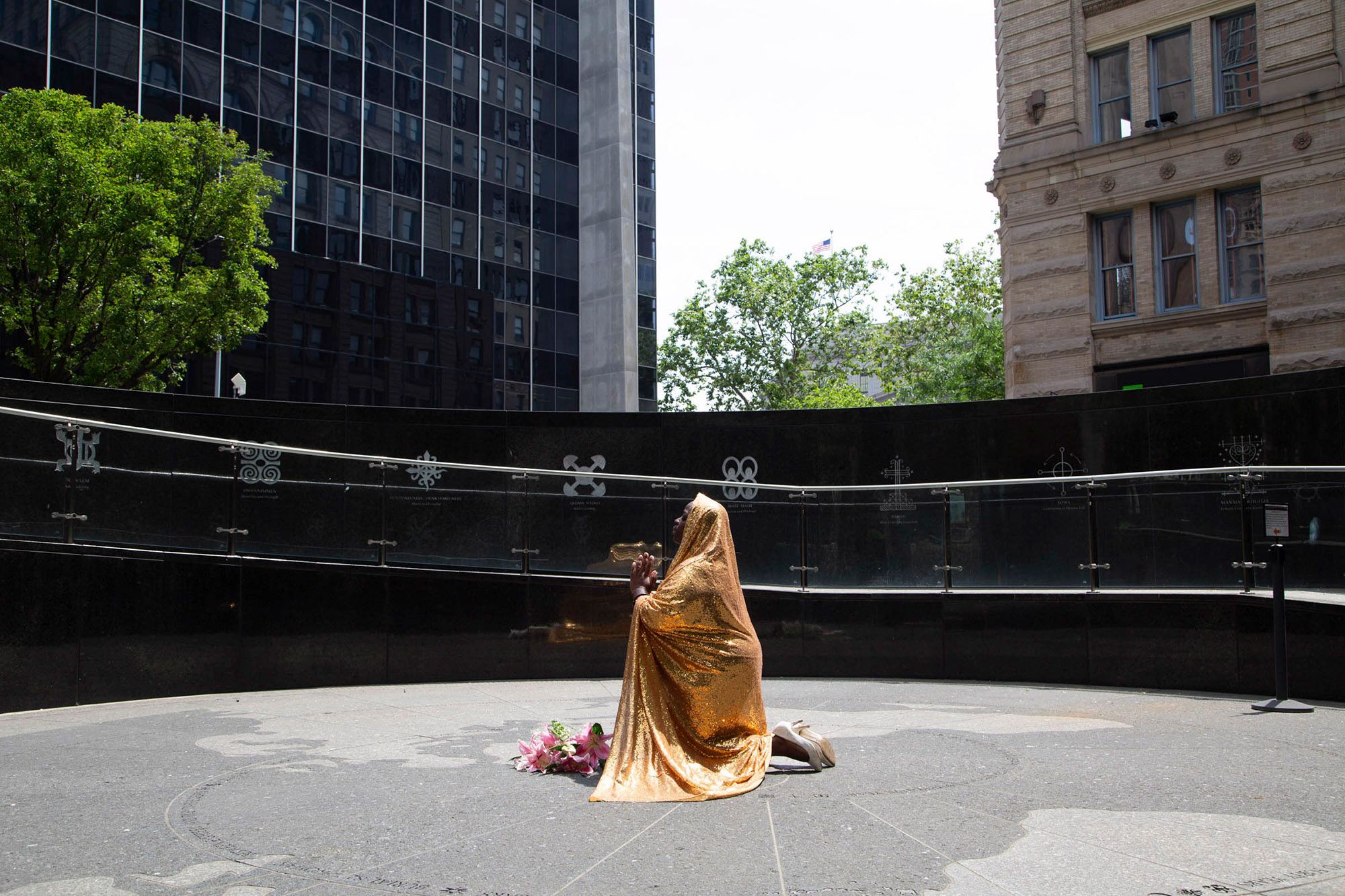
(CNN) — For over a decade, the photographer Nona Faustine shot self-portraits in and around New York City, in many instances posing fully nude apart from a pair of crisp white pumps. Faustine’s captivating photographs immerse viewers into often-forgotten histories; the series, “White Shoes,” highlights the city’s historic role in the transatlantic slave trade, as well as broader narratives about the perception of Black bodies in the arts.
It is currently on display at the Brooklyn Museum in an exhibition that marks the first solo show for Faustine, a Brooklyn native. Its photographs take viewers to locations across all five of New York City’s boroughs built — in many cases, literally — on enslaved people’s legacies.
Faustine was introduced to photography by her father and uncle, who brought her first camera when she was four years old, and took her first photography classes in elementary school. She began the body of work from which “White Shoes” is drawn during graduate studies at the International Center of Photography (ICP) program at Bard College.
“All my knowledge, everything I know about photography, and everything I know about history and life is part of the work. My heart and soul is in that series,” Faustine told CNN in an email. “It is fine art, conceptual and documentary photography combined.”
For centuries, New York City played a significant role in the enslavement of Black people. As early as the 1620s, Dutch settlers utilized enslaved labor to help build out the colony of New Amsterdam which became the city.
“Up to the Civil War, Wall Street, New York City financed the slavocracy in the south through its financing of the rising market for cotton,” explained Jacob Morris, the head of the Harlem Historical Society and architect of legislation to create a freedom trail in the city. “There was a lot of support for the system and the South, because of our making a lot of money off of (slavery) through the banking system.”
Enslaved people were sold at slave markets in New York City on Wall Street in Lower Manhattan starting for over 50 years in the 18th century. By 1730, forty-two percent of White households in the city enslaved Black people — the second-largest percentage of household slave ownership, after Charleston, South Carolina, in the United States.
Baring all, and bearing witness
Throughout “White Shoes,” Faustine wears a pair of white kitten heels — a symbol, she explained, of the pressures faced by Black women and girls to conform to Western beauty standards and the White patriarchy.
The series’ opener, a 2012 image titled “Venus of Vlacke Bos” (Vlacke Bos is Dutch for Flatbush), serves to highlight the impact of slavery in and on Brooklyn — in 1790, it was recorded that the borough had the highest number of enslaved people north of the Mason-Dixon line. In the photograph, Faustine is nude save for her heels and a pair of gloves, sitting on blue silk fabric in a studio with hands folded over her knee in a stylized, delicate pose. A tiara is balanced on her head, representing Western royalty and the dehumanizing ways White people treated enslaved Black women.
Faustine is nude throughout the early images in “White Shoes,” a conscious decision made, the photographer explained, to commemorate her ancestors, Black women today — and herself. In particular, she cited taking inspiration from daguerreotypes of Saartjie “Sarah” Baartman, a South African woman trafficked to Europe and exhibited as part of a human zoo in the early 19th-century.
“If you look back into the history of the Black body in art and photography, it’s highly problematic,” Faustine told CNN in an interview during a press preview for her exhibit. “I have never walked into a museum, until recently, and seen myself depicted on the walls the way I want to be represented.”
“This is a Black female body who’s given birth, who survived, who is a free woman and who is celebrating her freedom, her body and her people the way she wants to be celebrated and depicted,” she continued of her work. “But in the beginning it’s also giving acknowledgment to the ways we were brought here in chains. I am not playing a slave. I’m myself, Nona Faustine, in all of these images.”
The Black body, as a body of work
The Brooklyn Museum’s senior curator Catherine Morris, who organized the show alongside curatorial assistant Carla Forbes, noted the potent double entendre apparent in Faustine’s photographs. Take Faustine’s 2013 picture “From Her Body Came Their Greatest Wealth,” an image in which she stands alone on an apple box in the middle of Wall Street, nude with chains on her arms. Faustine’s stance exudes the confidence of a public orator, Morris explained, while monumentalizing the place where White people sold her ancestors. The photograph illustrates Faustine’s assurance in herself while highlighting the historical tragedies experienced by Black people at the very place she is reclaiming.

Mandatory Credit: Nona Faustine/Courtesy Brooklyn Museum via CNN Newsource
As the audience moves through the exhibition and Faustine’s body of work, she becomes more clothed — a symbolic depiction of the movement of time and progression by which Black people gained freedom.
“It is about time travel,” Faustine explained. “When you see me at the end, I’m fully closed and back in the present myself. So I have journeyed through the past and the presents symbolically.”
That journey is gradual: At first, Faustine is seen donning a black and a blue scarf on her head, but no other clothes to cover the rest of her body, in photos taken outside Brooklyn Borough Hall and a playground in Chinatown. In subsequent shoots across Brooklyn and Manhattan, Faustine — still topless, but now wearing a white skirt — holds props like a gun and a sign that quotes Sojourner Truth’s famous speech “Ain’t I A Woman,” honoring those who fought for the abolition of slavery.
And as the exhibition and her photographic journey comes to a close, Faustine wears a white dress and a straw hat, posing with her back facing the audience, in images taken at Shelter Island — where a plantation enslaved Africans and Native Americans from 1651 until 1820 — and Staten Island. In the very final image, she is seen wearing her everyday clothing.
Throughout “White Shoes,” Faustine implores her audience to confront these uncomfortable truths embedded in the very fabric of New York City while honoring the legacies of Black people who were woven into it.
“I want people to understand how far we’ve come. I want them to take pride… I want them to look into the story and know their history,” she said. “This is a history that is being censored and condemned all across the country now.”
The-CNN-Wire


